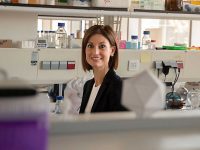
Jus lo front port vostra bella semblança
de què mon cors nit e jorn fa gran festa,
que remirant la molt bella figura
de vostra faç m’és romasa l’empremta
que ja per mort no se’n partrà la forma;
ans quan serai del tot fores d’est segle
cells qui lo cors portaran al sepulcre
sobre ma faç veuran lo vostre signe.
Estramps, Jordi de Sant Jordi (s. XV)
One’s face, their features, possibly the most exposed part of one’s body and the one we look at to find out what the person who talks and interacts with us is like and how they feel at the moment, the one we fall in love with, the part we mistrust… The face of the lover, which we model in our brain, the face of the children we love. They say that the face is the window of the soul. Or as a gentleman in love would put it, «Of your face I have already the imprint», and «on my forehead I bear your beautiful image”.
Years ago, when the first complete draft of the complete DNA sequence of the human genome had just been published, a fine arts student came to see me. I teach biology, but she was not addressing me as a teacher. She wanted to talk to me as a geneticist. She was a young girl with a sweet accent and vigorous mannerisms. She asked me if it was possible to determine what a person’s face looked like from their DNA. I replied that our physical characteristics are genetically determined, but that it is not the result of a single gene, but of many; that the human genome had only just been published and we were still a long way from knowing which genes would be relevant in determining specific physical characteristics. Then, Tanya (not her real name) explained to me that she had become pregnant as a teenager, the situation had overwhelmed her, and she had decided to have an abortion.
I did not have the answer she was looking for, nor could I have. At that time, even if I had access to DNA from the biological father and mother, or from the foetus, we did not know enough. But with today’s advances in genetics, the DNA from a biological sample can provide us with a lot of information, and we can infer a fairly detailed portrait of the face of the person to whom it belongs. We still have a long way to go and there are certainly many different genes involved, because we are not only talking about the colour of the skin or the eyes, but also the shape of the skull, the position of the eyes, the shape of the nose, the lips, the soft parts, the hair and hairline… Many of us resemble some of our relatives when we are little, but in adolescence our body grows, matures, and the face changes, because facial features do not all change at the same rate. Even so, patterns and relationships can be inferred between genotype (the DNA variants we have inherited from our parents) and phenotype (the final manifestation of these characteristics, the face in this case). At the moment, and by genetically analysing more than 8,000 people from different geographical origins, we know that at least 130 different genes are involved, many of which are very important during skeletal development (curiously, both in the development of the skull and the limbs). Some, when mutated, cause cleft lip or other rare diseases with facial dysmorphology. The shape of the nose, cheekbones, and chin are among the most genetically determined features. In contrast, the cheeks are among those most influenced by the environment (e.g., diet). With all this genetic data, albeit partial, it is now possible to draw our face from a bloodstain, a hair in a comb, or some buried bones. We have yet much to learn, but this technology is already being used to solve open forensic cases, or to get people unjustly sentenced for heinous crimes out of prison. «Of your face I have already the imprint.»





